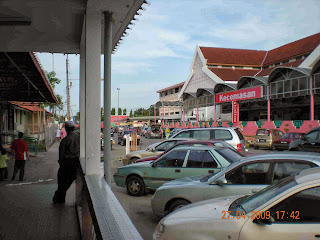How to get to Line Clear?
From Minden Heights, go down Jalan Sultan Azlan Shah to the roundabout at SEAMO-RECSAM. Take left into Jalan Masjid Negeri (Green Lane). Go down till Masjid Negeri Pulau Pinang then turn right onto Jalan Air Hitam, past Al-Mashoor School and Methodist Boys' School (MBS). Then take right at Jalan Dato Keramat and go down towards GAMA and KOMTAR. Go past KOMTAR and onward to Jalan Masjid Kapitan Keling. Turn back at Light Street till you meet the beginning of Penang Road (from the Fort Cornwallis side). Go down Penang Road slowly till you come to SAM's, stick right to enter the parking lot across from Line Clear and SAM'S. There is nowhere else to park nearby. Parking is RM4.00 for first hour and RM4.00 next 30 minutes, and thereafter. It will cost RM12 to park here and to have a decent meal at Line Clear and to wander around to nearby Chowrasta market (Pasar Chowrasta).
Alternatively, take the costal highway from Minden Heights to Weld Quay and down Light Street, turn onto Penang Road.
Crossing the road at Penang Road
Penang Road is a very busy road and I don't like it at all. But somehow you have to be daring enough to walk across and make it safely to the other side in one piece. J-walking or not, I didn't see a zebra-crossing nearby. Some cars have polite drivers who will wait for you to cross right in front of their cars, some are not that courteous. Be extra careful when you cross the road here.
Where is Line Clear?
Line Clear has a small unnoticeable signboard in between SAM'S signboards. Line Clear is situated in an alley between 2 of SAM's boutique shops. Line Clear is not near KOMTAR but before Chowrasta and Hutton Lane. You can't miss SAM's, so you can't miss Line Clear. Both SAM's and Line Clear are Indian enterprises and doing great business here.
What's special at Line Clear?
Line Clear operates 24 hours, so there is no such thing as a closing time. However, the Malaysian government has recently announced that 24-hour eateries must have a closing time for cleaning up. I will leave that topic alone. But for now, Line Clear is open 24 hours - which means you can come here and eat your favourite meals anytime. I like the idea. Yesterday (17 December 2013) was my second time eating at Line Clear. I only eat nasi briyani so I had nasi briyani here yesterday.
Nasi briyani - is it a glutton's delight?
I like nasi briyani and I can eat a plateful without talking to people next to me, including Affandi. "Why bother, why bother, why bother" as Azwan Ali's tagline has it. At Line Clear, the man serving (he is called Mamu or uncle) will put a lot of gravy on the rice. I had to tell him I didn't need that much curry but just a tablespoonful. Mamu said, people eat nasi briyani "banjir" style and I knew what he was referring to. But still I insisted mine is served with very little gravy as I cannot tolerate Indian curry. Mamu was confused rather than angry and tried to win me over but he understood what I meant. That is the limit I can tolerate Indian curry as it has been that way all my life - Indian curry is my limitation or I go to Klinik Aman with dehydration from full-blown diarrhoea. So I have to take extra care when it comes to Indian curry. I enjoyed my plate of tasty nasi briyani with little curry, a small piece of fried chicken drumstick, heaps of fried cabbage and cucumber. I had cold ais limau nipis drink to take down the oil and thirst on a hot afternoon. We paid about RM46 for 5 adults, which is reasonable.
What is after lunch?
There is no rush once one has dined at Line Clear. It pays to walkabout a little after a heavy lunch. We walked to Chowrasta market and went upstairs to first floor (tingkat atas). The shop lots were just opening and setting up shop for the afternoon. I guess they open after Zohor prayer. The Malay shop that sells batik and other Malay fabrics was closed - I guessed the old man there didn't want to open shop yesterday or he would appear later in the day. He sells very good quality batik and other fabrics and I don't have the nerve to bargain when a man that age sells me beautiful fabrics. We then looked around at the second-hand books and went down and out, back along Penang Road. We then stopped at Amoeba, next to Nasi Kandar near SAM's. This specialty shop sells very good clothes for youngsters and I bought a few clothes for my kids. Each piece is approx. RM29, not bad for an occasional shopper like me. It also sells good souvenirs.
We then returned to the parking lot and left Penang Road. It was a beautiful afternoon. I will return to Line Clear and to see Mamu again. I hope he lives long enough to serve me nasi briyani again.
 |
| Nasi briyani at Line Clear. |
Update: 2015
Line Clear was ordered to shut down.


































.jpg)
.jpg)
.jpg)

.jpg)
.jpg)

.jpg)
.jpg)
.jpg)
.jpg)
.jpg)
.jpg)
.jpg)
.jpg)
.jpg)

.jpg)













